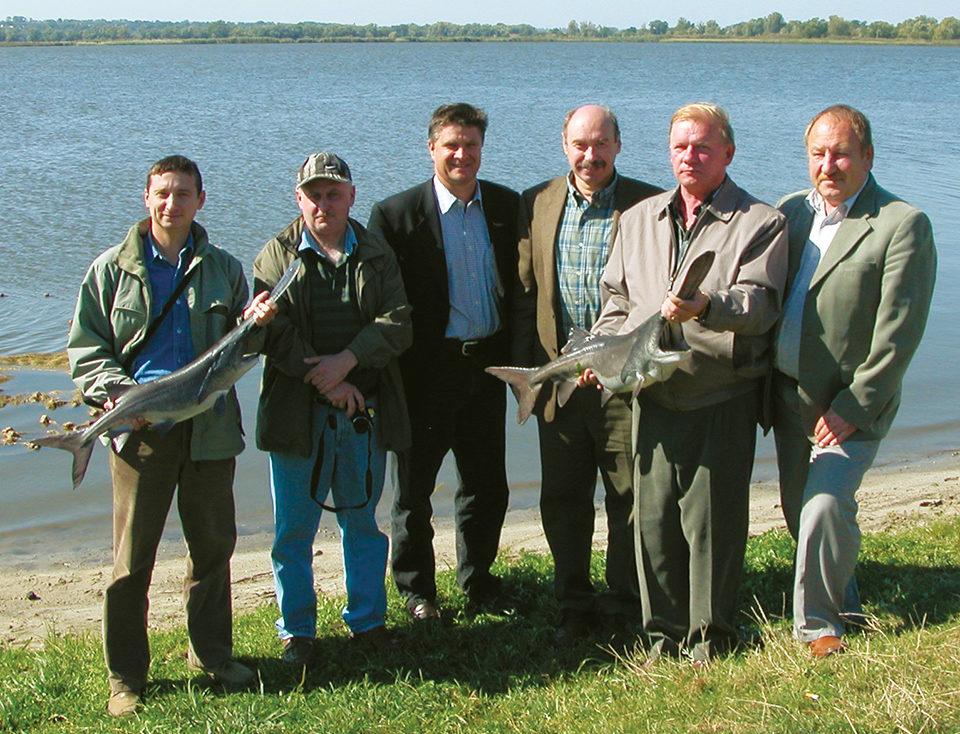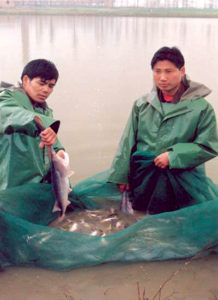Filter feeders consume zooplankton most of their lives

The American paddlefish (Polyodon spathula) is one of the most valuable native fishes in the United States, and many federal and state hatcheries in the U.S. are producing paddlefish for stock rehabilitation programs. Private culture of paddlefish is primarily at a research and developmental phase, but could provide an alternative source for paddlefish caviar and meat, and also alleviate pressure on capture fisheries.
The paddlefish, which is closely related to sturgeons, is the only member of the family Polyodontidae found on the American continent. The Chinese paddlefish is the only other living species in this family, but it is highly endangered in the Yangtze River of China.
Unlike the fish-eating Chinese paddlefish, American paddlefish are filter feeders that consume zooplankton throughout most of their lives. The filter-feeding nature of this caviar-producing species has made it desirable for introduction to culture in other parts of the world.
European development

Paddlefish were first introduced to Eastern Europe in 1974 and 1977 as part of a cooperative scientific effort between the U.S. Fish and Wildlife Service and its former Soviet counterpart, Acclimation Department of the All-Union Research Institute of Pond Fisheries. The imported paddlefish eggs, which originated from the state of Missouri, USA, were successfully raised at the Goryachi Klyouch Experimental Fish Breeding Plant located in the Krasnodar region near the Black Sea.
Paddlefish from these introductions provided the first broodstock that successfully reproduced during 1984-1986 in Russia. Since that time, several generations of paddlefish have been obtained, and the biotechnology for paddlefish propagation and rearing has been developed.
According to recent communications, seven hatcheries now carry out artificial propagation of American paddlefish in Russia. Over 10 million fertilized eggs, 7 million swim-up larvae, and 3 to 4 million advanced larvae are sold annually to producers in Russia and abroad. The center of paddlefish propagation and rearing is still the Krasnodar region. Paddlefish production in Russia has been primarily in pond polyculture with common carp and reservoir ranching.
From Russia, paddlefish have been distributed to other Eastern European countries including Romania, Moldavia, Ukraine, Hungary, and the Czech Republic. Some of these countries have now developed their own broodstock and established hatchery propagation.
In Ukraine, two established farms stock paddlefish instead of filter-feeding bighead carp in their polyculture systems. Last year, Ukraine produced 10 metric tons (MT) of paddlefish, with about 7 MT sold for meat and the remainder carried over for broodstock development and caviar production.
Long-term traditions of sturgeon culture and high demand for fish meat and black caviar have led paddlefish to be well received in the current aquaculture industry in Eastern Europe. These operations, which target high-end markets, have generated great interest in consumers.
China polyculture, ranching
In China, fertilized paddlefish eggs and larvae that originated in Missouri were first introduced in the mid- to late 1980s. Currently, 4-5 million fertilized eggs and larvae are imported into China every year from hatcheries in Russia and the United States.
Paddlefish that are polycultured in carp ponds are grown to 1 kg and sold to high-end restaurants. Paddlefish are also cultured for broodstock development and caviar production in connection with reservoir ranching. China recently reported a successful spawning of paddlefish in Hubei Province, the “bread basket” of China. In Xiantao City close to Wuhan, paddlefish have been successfully propagated and juvenile paddlefish cultured.
Paddlefish have been well accepted in high-end restaurants in large Chinese cities. Fish for caviar production are not available, but may be targeted for export markets.
Further culture potential
Information about paddlefish cultivation in other parts of the world is scarce. Recent communications have reported that paddlefish from China have been exported to Cuba, where the fish are grown in reservoirs for future caviar production. Additional information on paddlefish polyculture and reservoir ranching in the U.S. is available at www.sare.org/publications/factsheet/
0705.htm.
Further growth of the international paddlefish industry appears promising, with the establishment of broodstock and experience gained in propagation and cultivation techniques in both Eastern Europe and China.
(Editor’s Note: This article was originally published in the February 2006 print edition of the Global Aquaculture Advocate.)
Now that you've finished reading the article ...
… we hope you’ll consider supporting our mission to document the evolution of the global aquaculture industry and share our vast network of contributors’ expansive knowledge every week.
By becoming a Global Seafood Alliance member, you’re ensuring that all of the pre-competitive work we do through member benefits, resources and events can continue. Individual membership costs just $50 a year. GSA individual and corporate members receive complimentary access to a series of GOAL virtual events beginning in April. Join now.
Not a GSA member? Join us.
Author
-
Steven D. Mims, Ph.D.
Aquaculture Research Center
Kentucky State University
Frankfort, Kentucky 40601 USA
Tagged With
Related Posts

Intelligence
China’s limited paddlefish culture focused on meat production
Fish farmers rear paddlefish as a substitute for bighead carp in more than 10 provinces in China. Limited supply and high fingerling prices limit expansion of production.

Health & Welfare
Wastewater reuse supports paddlefish project
A pilot project in Kentucky that uses wastewater effluent and decommissioned tanks at a water treatment plant has cultured over 70,000 phase II paddlefish.

Intelligence
As sturgeon farming grows, demand concerns emerge
Caviar, or lightly salted sturgeon roe, has been enjoyed for centuries as an expensive gourmet delicacy. After a drastic decline in wild sturgeon stocks, aquaculture stepped in to fill the void. But can farmed supply find lasting balance with market demand?

Responsibility
In-pond raceway system demonstrates economic benefits for catfish production
Auburn University researched how to improve economic efficiency and profitability of catfish production with in-pond raceway systems. IPRS systems help achieve high levels of feed performance and fish survival, and lower production costs.


